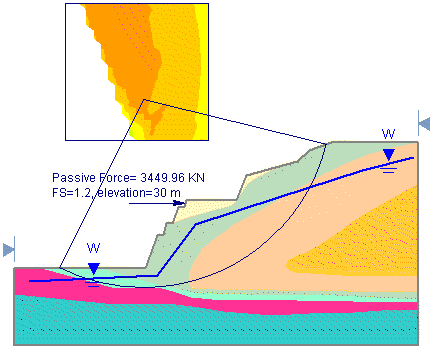Back Analysis of Support Force
A Back Analysis in Slide2 allows you to calculate the total support force required to achieve a specified factor of safety. For details about the Back Analysis option, see the Back Analysis of Support Force topic in the Slide2 Model section of this User Guide.
If a Back Analysis has been carried out, then the slip surface determined by the Back Analysis and the required support force can be displayed on the model in the Slide2 Interpret program.
Show Back Analysis Surface
By default, the surface determined by a Back Analysis, will automatically be displayed when you open the file in Interpret.
The display of this surface can be turned ON or OFF by selecting the Show Back Analysis Surface  option in the toolbar or the Back Analysis sub-menu of the Data menu.
option in the toolbar or the Back Analysis sub-menu of the Data menu.
Active Force / Passive Force
The required support force, can be assumed to act in either a PASSIVE or ACTIVE manner, in the limit equilibrium calculations. For a discussion of the significance of ACTIVE and PASSIVE support force, see the Active / Passive Force Application topic, in the Slide2 Model section of this Help system.
When the Back Analysis is carried out by the Slide2 COMPUTE engine, the required support force is always calculated using BOTH assumptions.
When the slip surface determined by the Back Analysis is displayed on the model, the required support force is also displayed. A horizontal force arrow, at the specified elevation, will be displayed, as shown in the figure below.

By default, the PASSIVE force is initially displayed, when a file is opened in Interpret. Either the ACTIVE or PASSIVE force can be displayed on the model, by selecting the desired option (Active or Passive) from the toolbar (use the drop-down shortcut menu beside the Show Back Analysis Surface toolbar button), or from the Back Analysis sub-menu of the Data menu.
- In general, the PASSIVE required support force will always be greater than the ACTIVE required support force. See the Active / Passive Force Application topic for more information.
- In most cases, the Back Analysis slip surface which is determined (for a given limit equilibrium analysis method), is the SAME SURFACE, for both ACTIVE and PASSIVE force assumptions.
Support Design Using the Back Analysis Results
So how can the Back Analysis results be used to design a support system? The results might be used as follows:
- The force magnitude determined by the Back Analysis, can be used to estimate the spacing and capacity of support.
- Depending on the type of support, either the ACTIVE or PASSIVE force can be used. For example, the ACTIVE force might be applicable for tensioned rock bolts. The PASSIVE force might be applicable for soil nails. In general, the PASSIVE (larger) force assumption, will lead to a more conservative support design.
- The slip surface which is determined can be used to estimate the required LENGTH of support (i.e. the user should ensure that the support has sufficient embedded length beyond the slip surface, which can supply the required support force).
Summary of Results in Report Generator
A summary of all Back Analysis results can be found in the Slide2 Interpret Report Generator. The Active and Passive force required, for each limit equilibrium analysis method performed, will be listed in the Report Generator.